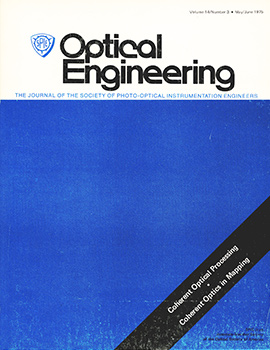Jan Grinberg, Alex Jacobson, William Bleha, Leroy Miller, Lewis Fraas, Donald Boswell, Gary Myer
Optical Engineering, Vol. 14, Issue 3, 143217, (June 1975) https://doi.org/10.1117/12.7971871
TOPICS: Liquid crystals, Photoresistors, Light valves, Electrodes, Modulation, Data processing, Cadmium sulfide, Dielectric mirrors, Glasses, Switching
A new, high-performance device has been developed for application to real-time coherent optical data processing. The new device embodies a CdS photoconductor, a CdTe light-absorbing layer, a dielectric mirror, and a liquid crystal layer sandwiched between indiumtin-oxide transparent electrodes deposited on optical quality glass flats. The non-coherent image is directed onto the photoconductor; this reduces the impedance of the photoconductor, thereby switching the ac vol-tage that is impressed across the electrodes onto the liquid crystal to activate the device. The liquid crystal is operated in a hybrid field effect mode. It utilizes the twisted nematic effect to create a dark off-state (voltage off the liquid crystal) and the optical birefringence effect to create the bright on-state. The liquid crystal modulates the polarization of the coherent read-out light so an analyzer must be used to create an intensity modulated output beam. Performance figures for the device include: Resolution 100 lines/mm; Input Sensitivity 160 iW/cm2 at 525 nm; Time Response on: 10. msec; off: 15 msec; Contrast >100 : 1 ; Aperture 1 inch by 1 inch.



 Receive Email Alerts
Receive Email Alerts